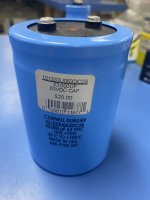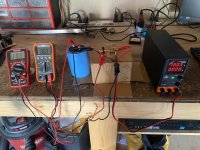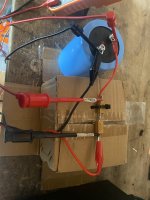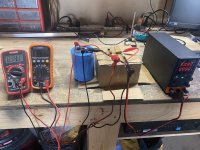I recently discovered my local electronics store has a whole pallet of these 33,000uf 63V caps and the owner sent me home with 4 free ones to try out. He informed me they have had them for 15+ years, so of course I am skeptical about them working.
What’s the best/easiest way to ensure these are properly charged and tested before trying to use 4 in a Pass Amp?
I purchased a variable power supply that can go up to 60V 5A. I was told I could slowly charge them by adding a 3K ohm 3 watt resistor in series. I was able to get a 3.4k ohm 10 watt resistor to use.
A few questions:
- how slow should I charge them with the DC supply? Or what process should I follow?
- is this method a way to test and ensure the caps work?
Any help or feedback is appreciated.
What’s the best/easiest way to ensure these are properly charged and tested before trying to use 4 in a Pass Amp?
I purchased a variable power supply that can go up to 60V 5A. I was told I could slowly charge them by adding a 3K ohm 3 watt resistor in series. I was able to get a 3.4k ohm 10 watt resistor to use.
A few questions:
- how slow should I charge them with the DC supply? Or what process should I follow?
- is this method a way to test and ensure the caps work?
Any help or feedback is appreciated.
Attachments
Those are 25 years old, and are good quality.
I would recommend more like 6k in series with one capacitor at a time, so the current is limited to 10mA.
Slowly raise the DC supply voltage 5-10V at a time, while monitoring the voltage across the series resistor.
After reaching 60V, allow the capacitor to cook for an hour or so. The current should be well under 1mA
at the rated voltage. When formed, slowly reduce the supply voltage to 0V , and then disconnect.
If possible, measure the ESR afterward, but they likely will be ok, and will improve further with use.
I would recommend more like 6k in series with one capacitor at a time, so the current is limited to 10mA.
Slowly raise the DC supply voltage 5-10V at a time, while monitoring the voltage across the series resistor.
After reaching 60V, allow the capacitor to cook for an hour or so. The current should be well under 1mA
at the rated voltage. When formed, slowly reduce the supply voltage to 0V , and then disconnect.
If possible, measure the ESR afterward, but they likely will be ok, and will improve further with use.
Last edited:
It's a way to reform the dielectric. After that, you can measure the discharging time constant to check the capacitance. Procedure:
Connect the supply via the 3.4 kohm, 10 W resistor to a 33000 uF, 63 V capacitor, switch the supply on and set it to 60 V, then wait for an hour.
Check that the voltage across the capacitor is indeed 60 V.
Disconnect the resistor and capacitor from the supply and discharge the capacitor via the resistor.
Measure the time until the voltage has dropped from 60 V to 60 V/e ~= 22.0728 V.
Divide the time you measured by the 3400 ohm resistance and you have the capacitance. If the capacitances are spot on, the time will be 112.2 seconds.
Repeat the whole procedure for the other three capacitors.
Edit: the dissipation in the electrolytic capacitor with a 60 V source and 3.4 kohm series resistor cannot exceed 265 mW. Because of the big size of the capacitors, I would expect that to be safe, but that's just educated guesswork. Rayma's procedure limits the power further and is therefore safer/more conservative.
Connect the supply via the 3.4 kohm, 10 W resistor to a 33000 uF, 63 V capacitor, switch the supply on and set it to 60 V, then wait for an hour.
Check that the voltage across the capacitor is indeed 60 V.
Disconnect the resistor and capacitor from the supply and discharge the capacitor via the resistor.
Measure the time until the voltage has dropped from 60 V to 60 V/e ~= 22.0728 V.
Divide the time you measured by the 3400 ohm resistance and you have the capacitance. If the capacitances are spot on, the time will be 112.2 seconds.
Repeat the whole procedure for the other three capacitors.
Edit: the dissipation in the electrolytic capacitor with a 60 V source and 3.4 kohm series resistor cannot exceed 265 mW. Because of the big size of the capacitors, I would expect that to be safe, but that's just educated guesswork. Rayma's procedure limits the power further and is therefore safer/more conservative.
Last edited:
Agree and add: charge the capacitor to 60V, disconnect it, measure that voltage and then wait 15 minutes, then remeasure what voltage it self discharged to.
If in good/very good condition it would mostly hold up, maybe lose a couple V.
IF it self discharges to less than 50V, I wouldn´t trust it beyond that voltage, whatever it is.
If in good/very good condition it would mostly hold up, maybe lose a couple V.
IF it self discharges to less than 50V, I wouldn´t trust it beyond that voltage, whatever it is.
Perfect. Thank you all for the input. I bought two of the 3.4k resistors and can wire them in series to get over 6k and try Rayma’s method.
All seems to make sense, but what should I set the Amperage to? The power supply can go up to 5A.
And how can I measure ESR? I just have a multimeter.
All seems to make sense, but what should I set the Amperage to? The power supply can go up to 5A.
And how can I measure ESR? I just have a multimeter.
Any current limit setting greater than 10 mA will do, the current won't exceed 60 V/6.8 kohm anyway.
Those big industrial caps made by reputable manufacturers look ~eternal: I have examples made in the early seventies, and when I need to use one, I do not even bother testing or reforming it. I know from experience that they are going to be OK.
I am much more circumspect with high voltage types (>100V), as the reforming can sometimes be more violent.
That said, testing them through a resistor first is certainly the safest way to go and does no harm.
As for the characteristics, rely on the datasheet or invest in a specialized instrument (it will need to have a good resolution and Kelvin connections to measure the ESR reliably)
I am much more circumspect with high voltage types (>100V), as the reforming can sometimes be more violent.
That said, testing them through a resistor first is certainly the safest way to go and does no harm.
As for the characteristics, rely on the datasheet or invest in a specialized instrument (it will need to have a good resolution and Kelvin connections to measure the ESR reliably)
That’s good to hear. If I can confirm all 4 work fine, I’ll test them in an amplifier to see how they work.Those big industrial caps made by reputable manufacturers look ~eternal: I have examples made in the early seventies, and when I need to use one, I do not even bother testing or reforming it. I know from experience that they are going to be OK.
I am much more circumspect with high voltage types (>100V), as the reforming can sometimes be more violent.
That said, testing them through a resistor first is certainly the safest way to go and does no harm.
As for the characteristics, rely on the datasheet or invest in a specialized instrument (it will need to have a good resolution and Kelvin connections to measure the ESR reliably)
The DC power supply just came in. I have a total of 6.9k ohm of resistors in series with the cap and measuring across the resistors now while watching voltage on the cap. I’m slowly bringing it up 5 V every 30-60 seconds.
Attachments
I’m in Houston. I told them if the caps worked and there weren’t problems with the ones I have I would ask what kind of deal they would give me if I bought them in bulk. They currently sell them now for $20 each but have always gived me a good deal on their parts. They also have the sized up clamps for cheap.
I followed Raymas method for slowly charging and discharging the caps. I will hook them up this week and test on an amp within the next week.
I followed Raymas method for slowly charging and discharging the caps. I will hook them up this week and test on an amp within the next week.
If the capacitors are stored for long time, you need to reform the capacitors before you decide it bad.
This video might be helpful. Regards.
This video might be helpful. Regards.
Get a graphic capacitance meter, they have tiny dot matrix displays, less than $20 here in India in open form, a little more in a case.
Representative image from net, no ties to seller:
https://www.googleadservices.com/pa...vaH7fT4AhUE3HMBHWopA6gQ9aACKAB6BAgBEEQ&adurl=
https://www.googleadservices.com/pa...vaH7fT4AhUE3HMBHWopA6gQ9aACKAB6BAgBEEQ&adurl=
- Home
- Design & Build
- Parts
- Got these caps, how can I test them?



